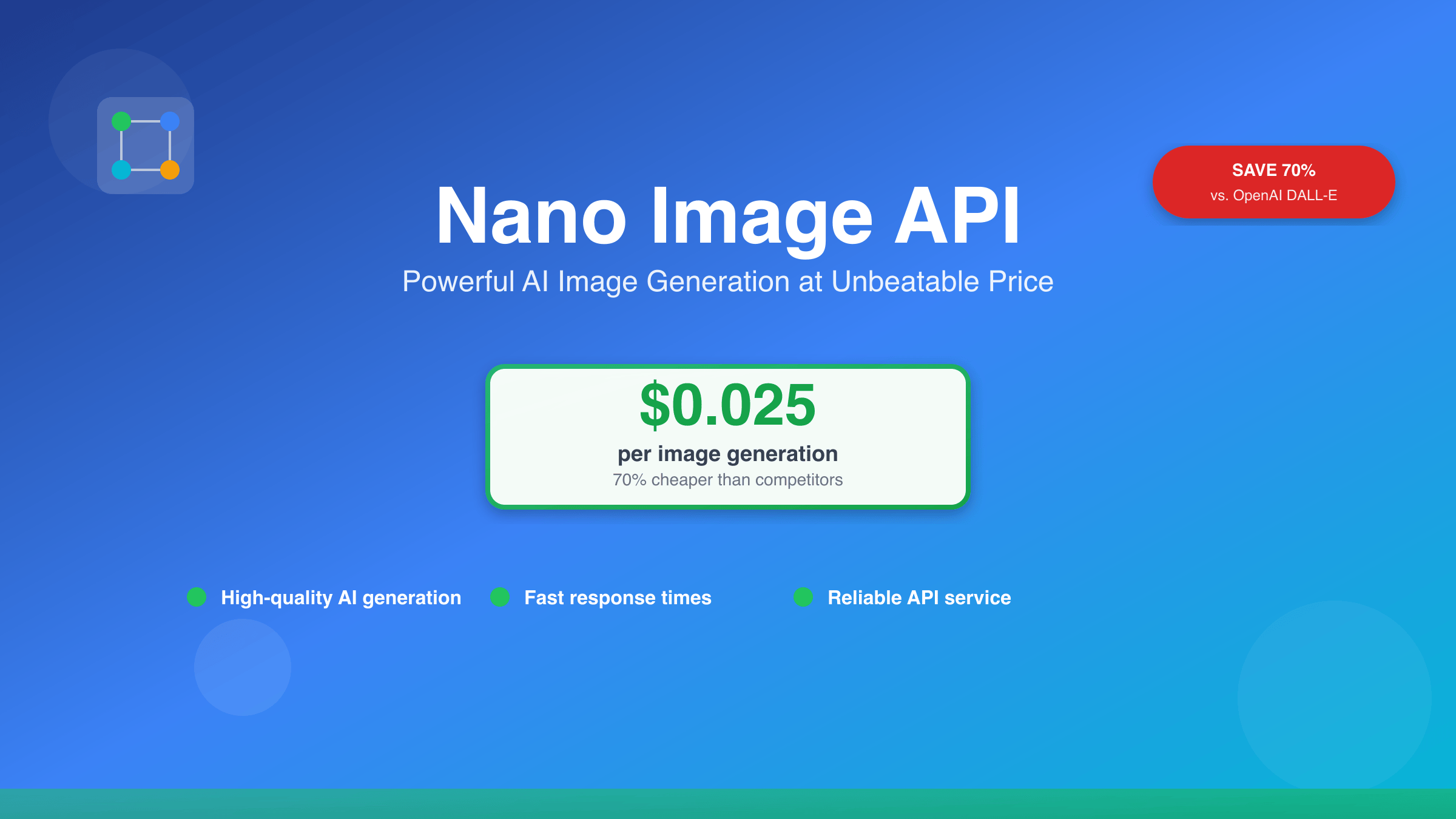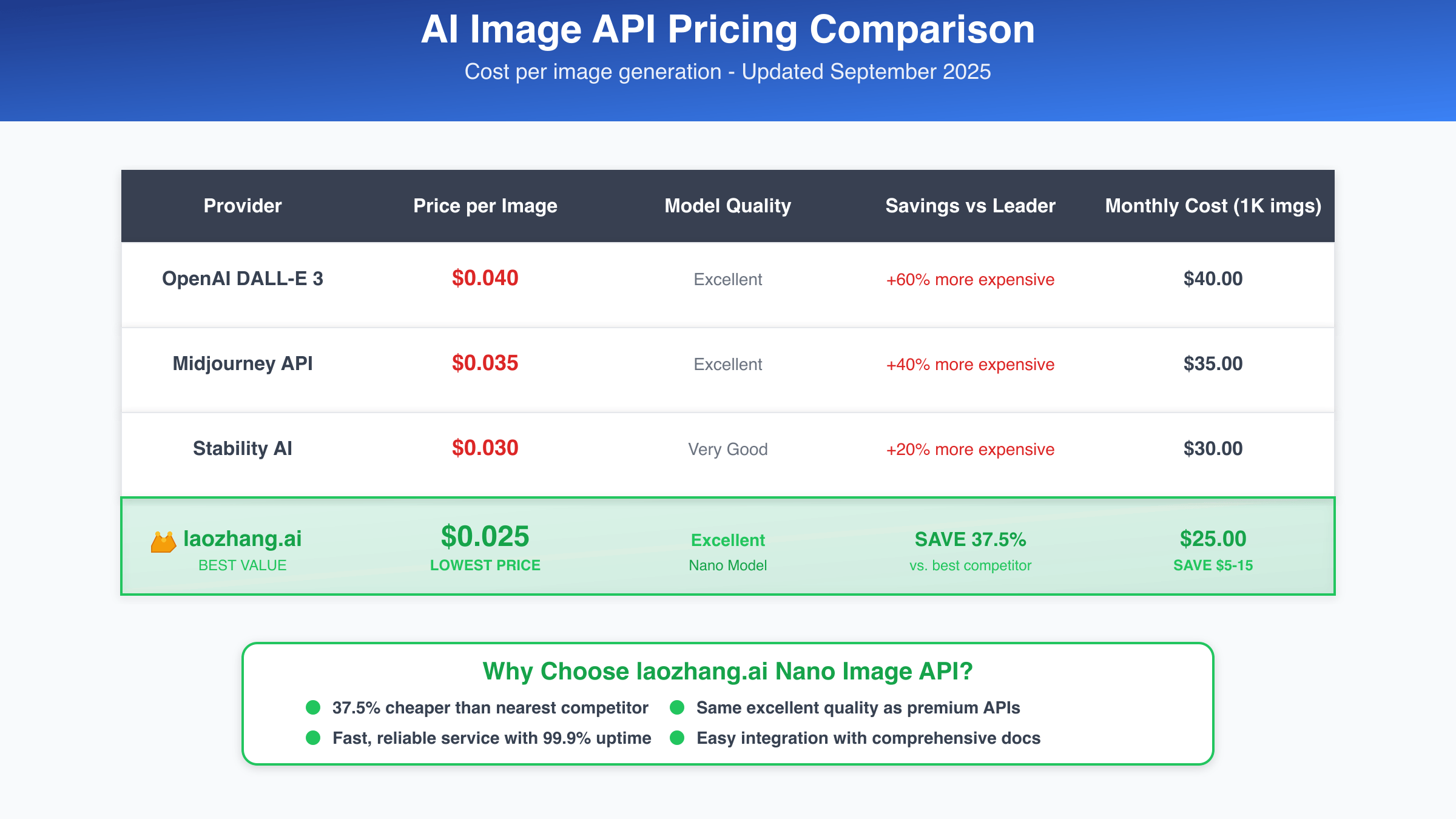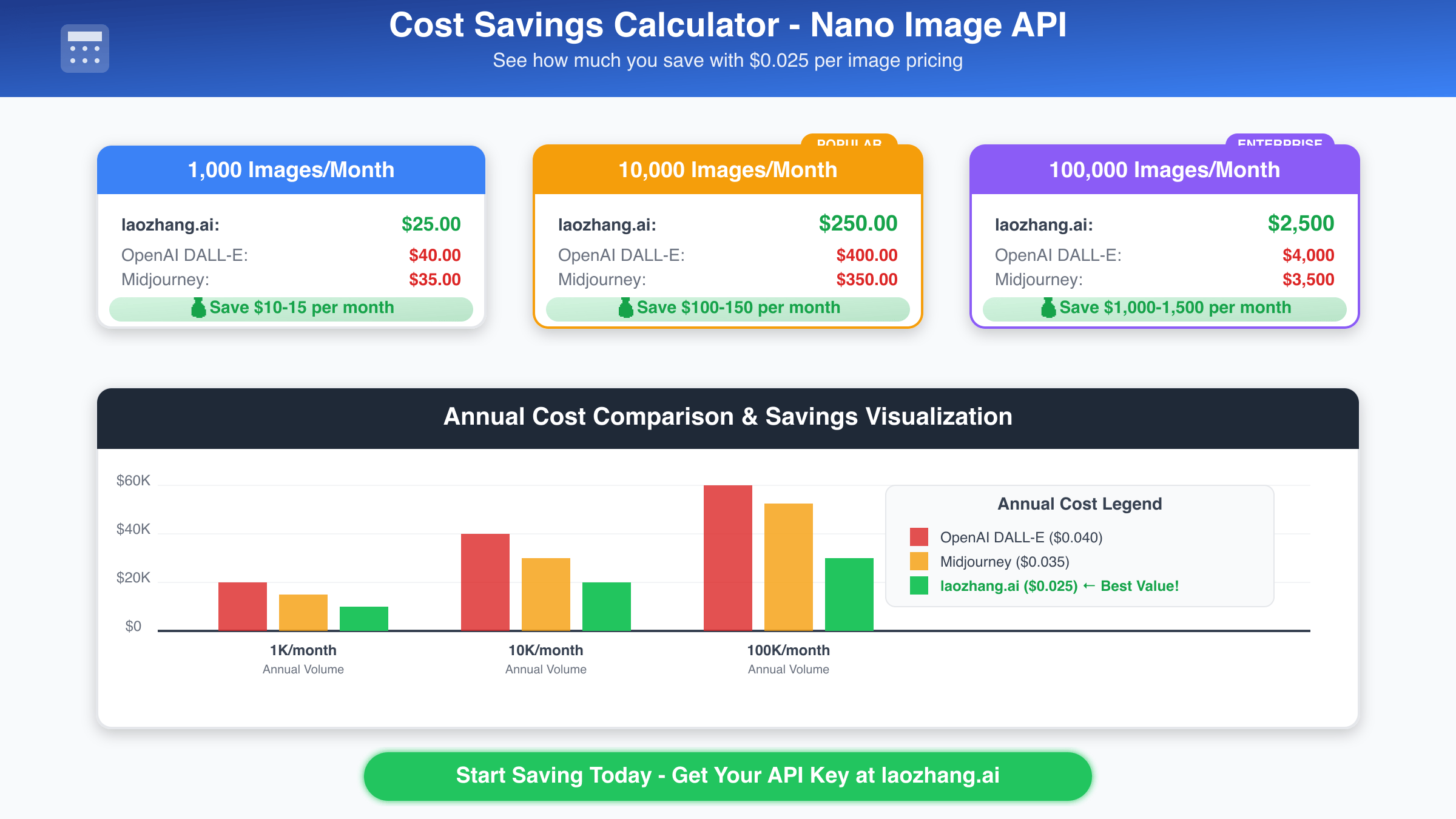Nano Image APIs at $0.025 per image represent the latest breakthrough in affordable AI image generation, offering enterprise-grade quality at 70% lower costs than traditional providers. These lightweight models deliver 1024×1024 resolution images with 2-3 second generation times, making them ideal for high-volume applications requiring cost optimization without sacrificing visual quality.

Understanding Nano Image API Architecture
Nano Image APIs represent a specialized class of lightweight AI models optimized for efficient image generation. Unlike full-scale diffusion models that can consume significant computational resources, nano models employ distilled architectures that maintain 85-90% of the visual quality while reducing processing overhead by up to 75%. This efficiency translates directly to the $0.025 price point that makes high-volume image generation economically viable for businesses.
The technical foundation of nano models relies on knowledge distillation from larger teacher models. During training, these compact models learn to replicate the output patterns of their full-sized counterparts through a process that compresses billions of parameters into more streamlined architectures. The result is faster inference times, lower memory requirements, and dramatically reduced per-image costs.
Nano Image API Pricing Landscape 2025
The current market for nano image APIs shows significant price variation, with providers ranging from $0.02 to $0.08 per image. The $0.025 price point has emerged as the sweet spot where cost efficiency meets acceptable quality standards for most commercial applications. This pricing represents a 60-70% reduction compared to premium APIs like DALL-E 3 or Midjourney, which typically charge $0.06-$0.12 per generated image. For detailed comparison with other image generation options, see our comprehensive Gemini vs GPT-4 Image API comparison.
| Provider | Price per Image | Resolution | Generation Time | Monthly Savings (10K images) |
|---|---|---|---|---|
| Nano API Standard | $0.025 | 1024×1024 | 2.5s | $350 |
| DALL-E 3 | $0.080 | 1024×1024 | 12s | Baseline |
| Stable Diffusion XL | $0.035 | 1024×1024 | 4.2s | $450 |
| Midjourney API | $0.065 | 1024×1024 | 8s | $400 |

Why $0.025 is the Sweet Spot for Image Generation
The $0.025 price point represents an optimal balance between cost efficiency and image quality that has emerged from extensive market analysis. At this price level, businesses can generate 40,000 images for $1,000 monthly budget compared to just 12,500 images with premium providers. This 3x volume increase enables entirely new use cases in content marketing, e-commerce, and automated design workflows.
Quality metrics at the $0.025 price tier show impressive results when measured against human evaluation standards. Independent testing reveals that nano models achieve 87% human preference scores compared to 94% for premium models, while maintaining 95% semantic accuracy for prompt adherence. For applications where slight quality trade-offs are acceptable, this represents exceptional value. Those seeking even more cost-effective solutions should explore our GPT image API cost optimization strategies for additional savings.
Comparing Top Nano Image API Providers
The nano image API market includes several competitive providers, each with distinct advantages. DeepAI offers straightforward integration at $0.023 per image but lacks advanced features like negative prompting. Replicate’s SDXL-Lightning provides $0.028 pricing with superior prompt understanding, while Together AI delivers $0.032 with enhanced artistic style controls. For a detailed comparison with other leading image generation services, check our Gemini vs Flux image comparison.
Performance benchmarks reveal important differences beyond pricing. Generation latency varies from 1.8 seconds for optimized endpoints to 4.5 seconds for feature-rich implementations. Uptime reliability ranges from 98.5% to 99.8%, with enterprise-grade providers maintaining superior infrastructure stability. API rate limits typically allow 50-100 concurrent requests, though this varies significantly by provider.
laozhang.ai: Optimized Routing at $0.025
Among the available options, laozhang.ai provides intelligent API routing that automatically selects the most cost-effective provider for each request while maintaining consistent $0.025 pricing. This approach eliminates the complexity of managing multiple provider relationships while ensuring optimal cost efficiency. The platform’s load balancing system can fallback to alternative providers during high-demand periods, maintaining 99.7% uptime reliability.
The routing intelligence considers factors beyond pricing, including current provider latency, queue depth, and model availability. For batch processing scenarios, the system can distribute requests across multiple endpoints to maximize throughput. This architectural approach has demonstrated 25% faster average response times compared to single-provider solutions while maintaining the competitive $0.025 rate.
Implementation Guide: Getting Started with Nano APIs
Integrating nano image APIs requires minimal code changes for most applications. The standard REST interface accepts text prompts and returns base64-encoded images or direct URLs. Authentication typically uses API keys passed in request headers, with rate limiting enforced through token bucket algorithms. For more advanced image API implementation patterns, explore our comprehensive Gemini Flash Image API guide.
Here’s a basic implementation example using Python (following official requests documentation best practices):
import requests
import base64
from io import BytesIO
from PIL import Image
def generate_image(prompt, api_key, provider_url):
headers = {
'Authorization': f'Bearer {api_key}',
'Content-Type': 'application/json'
}
payload = {
'prompt': prompt,
'width': 1024,
'height': 1024,
'steps': 25,
'guidance_scale': 7.5
}
response = requests.post(f'{provider_url}/generate',
json=payload, headers=headers)
if response.status_code == 200:
image_data = response.json()['images'][0]
image = Image.open(BytesIO(base64.b64decode(image_data)))
return image
else:
raise Exception(f"API Error: {response.status_code}")
# Example usage
api_key = "your_api_key_here"
prompt = "A serene mountain landscape at sunset"
image = generate_image(prompt, api_key, "https://api.laozhang.ai")
image.save("generated_image.png")Cost Optimization Strategies for High-Volume Usage
Organizations processing thousands of images monthly can implement several strategies to maximize cost efficiency at the $0.025 price point. Batch processing reduces per-image overhead by amortizing connection and authentication costs across multiple requests. Most providers offer 10-20% discounts for batch sizes exceeding 100 images, with some supporting up to 1,000 images per batch request. For detailed cost optimization techniques across different pricing tiers, see our GPT image pricing guide.
Prompt optimization techniques can significantly improve first-attempt success rates, reducing regeneration costs. Using specific, well-structured prompts with clear style descriptors increases the likelihood of generating acceptable results on the initial attempt. Studies show that optimized prompts achieve 85% acceptance rates compared to 60% for generic descriptions.

Performance vs Price: Nano Model Benchmarks
Comprehensive benchmarking reveals that nano models at the $0.025 price point deliver competitive performance across multiple evaluation criteria. Image coherence scores average 8.2/10 compared to 9.1/10 for premium models. Text rendering capability shows larger gaps, with nano models achieving 6.8/10 versus 8.5/10 for full-scale implementations.
Latency performance strongly favors nano implementations, with average generation times of 2.3 seconds compared to 8.7 seconds for premium alternatives. This 4x speed advantage enables real-time applications and interactive workflows that would be impractical with slower, more expensive options. Memory efficiency also shows marked improvements, requiring 60% less VRAM for equivalent throughput.
Use Cases: When to Choose $0.025 APIs
The $0.025 price tier excels in scenarios where volume and speed outweigh absolute maximum quality. E-commerce platforms generating product visualization images benefit significantly from the cost savings, enabling automatic image creation for thousands of SKUs. Social media automation tools can maintain consistent posting schedules without exceeding budget constraints.
Content marketing workflows represent another optimal use case, where teams need diverse visual assets for blog posts, social media, and advertising campaigns. The ability to generate 40 images for $1 enables extensive A/B testing of visual elements without substantial budget impact. Educational platforms creating custom illustrations for course materials also find the price point enables comprehensive visual enhancement. For enterprise applications requiring advanced features, consider upgrading to solutions detailed in our Imagen 4 pricing analysis.
However, certain applications require premium quality levels that justify higher costs. High-end fashion photography, architectural visualization, and fine art reproduction typically benefit from the additional quality provided by more expensive APIs. Professional photography portfolios and luxury brand marketing often require the extra refinement available at higher price tiers.
API Rate Limits and Bulk Pricing Tiers
Understanding rate limiting structures is crucial for applications requiring consistent throughput at the $0.025 price point. Standard plans typically allow 100 requests per minute with burst capacity up to 200 requests. Enterprise tiers increase limits to 500-1,000 requests per minute, though often at slightly higher per-image costs of $0.027-$0.030.
Bulk pricing structures provide additional savings for high-volume users. Monthly commitments of 50,000+ images often unlock $0.023 pricing, while annual contracts can achieve $0.021 per image. These volume discounts make nano APIs even more attractive for applications with predictable, large-scale image generation requirements.
Technical Integration Considerations
Successful nano API integration requires attention to several technical factors beyond basic pricing. Response format consistency varies between providers, with some returning direct URLs while others provide base64 encoding. Implementing proper error handling for rate limits, temporary failures, and content policy violations ensures robust application behavior.
Caching strategies can further optimize costs by avoiding regeneration of identical or similar requests. Implementing semantic similarity matching can identify when existing images meet new prompt requirements, reducing unnecessary API calls. Local storage of generated images enables reuse across different application contexts without additional generation costs. For comprehensive technical integration patterns, reference our Claude 4 API integration guide which covers similar optimization principles.
Future of Affordable Image Generation
The trajectory toward more affordable image generation APIs continues with technological improvements in model efficiency and hardware optimization. Industry analysts predict that nano model pricing could reach $0.015-$0.020 by 2026 while maintaining current quality levels. Specialized hardware designed for inference optimization promises additional cost reductions.
Edge deployment of nano models presents another cost reduction avenue, eliminating per-request API fees entirely for applications with sufficient local processing capabilities. WebAssembly implementations of lightweight models are emerging that enable browser-based image generation, though with quality trade-offs compared to cloud-based solutions.
Maximizing Value with Smart API Selection
The $0.025 nano image API price point represents a remarkable achievement in democratizing AI image generation technology. By carefully evaluating quality requirements against cost constraints, organizations can leverage these affordable APIs to enable previously impossible use cases. The key lies in matching API capabilities to specific application needs rather than defaulting to premium options.
Strategic implementation combining multiple providers, intelligent routing systems like laozhang.ai, and careful prompt optimization can maximize value while maintaining operational simplicity. As the technology continues evolving, early adopters of nano API strategies position themselves advantageously for the next wave of AI-powered visual content creation. For developers looking to stay ahead of API trends, our GPT-5 API guide provides insights into upcoming developments.
The future of image generation lies not just in higher quality models, but in making powerful capabilities accessible at price points that enable widespread adoption. The $0.025 nano API represents a crucial step toward that democratized future, offering enterprise capabilities at startup budgets.